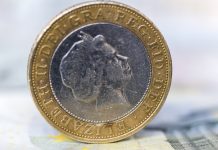Concerns over the health of the German economy sent the euro sharply lower on Wednesday. Meanwhile the pound was steady despite little Brexit progress. The pound euro exchange rate rallied to a peak of €1.1392 before closing the session 0.3% higher at €1.1381. The pound euro exchange rate is edging higher in early trade on Thursday.
| What do these figures mean? |
|---|
| When measuring the value of a pair of currencies, one set equals 1 unit and the other shows the current equivalent. As the market moves, the amount will vary from minute to minute.h If the euro amount increases in this pairing, it’s positive for the pound. Or, if you were looking at it the other way around:1 EUR = 0.87271 GBPIn this example, €1 is equivalent to approximately £0.87. This measures the euro’s worth versus the British pound. If the sterling number gets larger, it’s good news for the euro. |
With no high impacting data released on Wednesday, pound traders were once again focusing on Brexit. UK Prime Minister Theresa May has made little progress leaving investors hoping for an extension to Brexit beyond the 29th March.
Today investors will look towards the Bank of England’s (BoE) monetary policy announcement. Analysts are expecting the BoE to keep monetary policy unchanged, as they did in November and December last year. Given that Brexit is just 50 days away there aren’t many options on the table for the central bank, other than to watch and wait.
The direction of the economy and monetary policy depends on what type of Brexit is agreed. There is still no plan as to what Brexit will look like. The House of Commons has voted down Theresa May’s Brexit deal. Theresa May has not been able to secure any variations to her current proposal with the EU, as Parliament had instructed her to do.
Consequently, the BoE are likely to continue warning over the damage of a no deal Brexit. Market participants are also expecting the central bank to stick with its one hike per year plan, once Brexit clouds start to clear.
| Why do raised interest rates boost a currency’s value? |
|---|
| Interest rates are key to understanding exchange rate movements. Those who have large sums of money to invest want the highest return on their investments. Higher interest rate environments tend to offer higher yields. So, if the interest rate or at least the interest rate expectation of a country is relatively higher compared to another, then it attracts more foreign capital investment. Large corporations and investors need local currency to invest. More local currency used then boosts the demand of that currency, pushing the value higher. |
More Weakness From German Industrial Production Data?
Concerns over the state of the eurozone economy have been weighing on demand for the euro. German recession fears grew again on Wednesday as German factory orders fell for a second straight month. Orders have declined by a shocking 7% year on year, after unexpectedly declining a massive -1.6% in December. Analysts had been forecasting a 0.3% increase.
The extent of weakness in the German manufacturing sector shows the economy is struggling amid trade tensions, slowing global growth and Brexit anxiety. German economy growth shrank by -0.2% in the third quarter last year. Market participants will be increasingly concerned that the economy kept shrinking in the final quarter, pulling Germany into recession. The weak data from Europe’s largest economy pulled the euro lower.
| Why does poor economic data drag on a country’s currency? |
|---|
| Slowing economic indicators point to a slowing economy. Weak economies have weaker currencies because institutions look to reduce investments in countries where growth prospects are low and then transfer money to countries with higher growth prospects. These institutions sell out of their investment and the local currency, thus increasing supply of the currency and pushing down the money’s worth. So, when a country or region has poor economic news, the value of the currency tends to fall. |
Today, the spotlight will remain on Germany with the release of Industrial production figures. Industrial production declined in November by a staggering -1.9%. Continued signs of weakness in Germany, the powerhouse of Europe’s industrial sector, could pull the euro lower.
This publication is provided for general information purposes only and is not intended to cover every aspect of the topics with which it deals. It is not intended to amount to advice on which you should rely. You must obtain professional or specialist advice before taking, or refraining from, any action on the basis of the content in this publication. The information in this publication does not constitute legal, tax or other professional advice from TransferWise Inc., Currency Live or its affiliates. Prior results do not guarantee a similar outcome. We make no representations, warranties or guarantees, whether express or implied, that the content in the publication is accurate, complete or up to date. Consult our risk warning page for more details.
This article was initially published on TransferWise.com from the same author. The content at Currency Live is the sole opinion of the authors and in no way reflects the views of TransferWise Inc.





